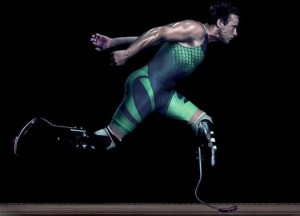“The Blade Runner” One Step Closer to Olympic Dream 7
Try to wrap your brain around this scene:
An 11-month-old South African baby lies in a post-op recovery room, having just had both legs amputated just below the knees.
As his parents hover over the boy, they put aside their own doubts and fears to bravely speak words of affirmation and hope.
Yet secretly, in private moments, they wonder how their child will ever cope in a world populated by people with legs, ankles and feet.
As is true in much of life, the outward appearance often speaks the loudest while hidden inside, the attributes of courage, heart and determination quietly do their work and ultimately have the last word.
Oscar Pistorius was born without fibulae (lower leg bones). His deformed lower legs were surgically removed before he was a year old. He was fitted with carbon fiber prostheses which emulate the function of leg bones, ankles and feet.
In time, the boy with no legs became actively involved in rugby, water polo and tennis. In 2004, he took up running as a therapeutic recovery exercise following a rugby injury.
Before long he was dominating every Paralympics race he entered, from 100m through 400m. Eventually he became the world record holder in the “disabled” version of the 100m, 200m and 400m sprints.
In Beijing, 2008, he won sprinting’s Olympic triple crown (100m, 200m, 400m).
The “disabled” version.
Some would say his accomplishments represented the peak of his potential. But Oscar knew other, more able-bodied runners were producing faster times—and he wanted to run with the big dogs.
He even had visions of one day running beside the world’s best in the World Championships and especially in the Olympics. Read the rest of this entry →




